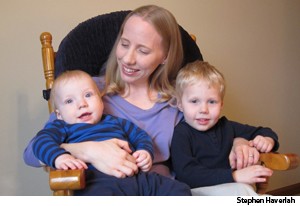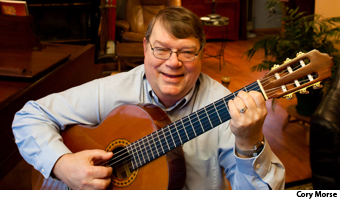Even the most popular had no more than five mentions each: “Abide With Me”; “Children of the Heavenly Father”; “Amazing Grace”; “A Mighty Fortress”; “Beautiful Savior”; “I Was There to Hear Your Borning Cry”; “Lord, Thee I Love with All My Heart”; and “My Life Flows On In Endless Song.”
And as people shared the hymns that made a difference in their lives, they often attached sheet music, lyrics, historical background or ranked lists of favorites. One, Gayle Moyer of St. Paul Lutheran Church, Telford, Pa., sent a photo of her license plate: “HYMN-LVR.”
Per Harling, a Church of Sweden pastor who wrote “You Are Holy” (Evangelical Lutheran Worship, 525), said hymns shape our theology; bring generations together; give voice to prayer, praise and lament; and bring us into “worship with those who have been, with those who are and with those who will be members of the Christian church.
“[There may be] no more burglary-safe possession [than a hymn and song] we know by heart. Hymn texts are usually the kind of texts to live and die on. Very few people have died with a sermon on their lips, but many have a memorized hymn text in their very last life moment.”
Light in darkness
Many readers told of the hope that hymns brought to ill or dying loved ones or their family and friends.
“It’s been a rough stretch for our congregation, with sickness and tragedy falling on many beloved members,” wrote Charles Strietelmeier, pastor of Augustana Lutheran, Hobart, Ind. “We’ve [needed] nourishing hymns to sustain our spirits [like] the ardent simple joy of ‘Lord Jesus, You Shall Be My Song’ (ELW, 808).”
Karen Taylor, music director of St. Timothy Lutheran Church, Lakewood, Calif., wrote about a trip home in 2006 to help her parents: “Mom was exhausted. Dad had suffered from Parkinson’s and congestive heart failure for 10 years; walking, talking and swallowing had become nearly impossible.”
Taylor’s mother apologized for not being able to sing hymns together due to her father’s illness. “I suggested we try anyway, and Mom chose ‘Abide with Me’ (ELW, 629). To our surprise, Dad perked up and sang along. Mom and I were moved to tears by the sound of his long-disabled but still beautiful voice,” she said.
Music and grief have been Elizabeth Damico’s companions from an early age after her mother’s death. The church musician at Holden Village, Chelan, Wash., said in seasons of doubt, “my mouth cannot say the words; my heart aches too much to hope; and my mind is overcrowded with questions and cynicism. Yet somehow, my hands believe.”
After his “strong and brave” brother-in-law committed suicide, Kyle Debertin, Lutheran Church of Our Redeemer, Watertown, S.D., drew strength at the funeral from contemporary Christian musician Chris Rice’s “Come to Jesus.”
“In the midst of the numbness, surrounded by his fellow firefighters and National Guard soldiers, every word of ‘Come to Jesus’ … reminded me of Christ’s presence with Dan as he was alone in his garage that final day,” Debertin wrote. “Post-traumatic stress disorder is real and strong, but so is the loving grace of Jesus.”
Readers often found strength with the gathered community. Three days after her parents died in a car accident, organist Laura Stransky, Christ the King Lutheran, Durango, Colo., and her husband attended the All Saints Day service. As the congregation sang, Stransky played “For All the Saints” (ELW, 422). “Some people were amazed that my husband and I came to church that day, but we needed to be there,” she said.
Comfort, in times of fear
Vanessa von Phul, Messiah Lutheran Church, Weatherford, Texas, doesn’t remember the helicopter ride or that she made the evening news. “My gentle mare spooked, bucked, bolted and slammed me face-first into a steel fence,” she said.
During months of recovery, “I felt small, helpless and ashamed of [my] judgment errors,” she said. “The Spirit sang me to sleep when my broken heart was as painful as broken bones: ‘Have no fear, little flock; Have no fear, little flock’” (ELW, 764). Von Phul recovered fully, bought a helmet and is back riding her beloved horse.
ELCA military chaplains turn to the church’s hymnody as well. In 2012, when Lori Kleppe served with the U.S. Marine Corps in Afghanistan, she was thankful for Marty Haugen “on a regular basis. His ministry of music [nurtured] weary souls: ‘Shepherd me, O God, beyond my wants, beyond my fears, from death into life’ (ELW, 780).”
Gary Bertsch, an Air Force chaplain in San Antonio, said John Ylvisaker’s “I Was There to Hear Your Borning Cry” (ELW, 732) “captures the promises of baptism from birth until death. With our airmen I stress how baptism is that promise which stands by us as we journey down life’s path, no matter where that path might lead us.”
“My Life Flows On in Endless Song” (ELW, 763) took on deep meaning nine years ago for Debbie Beahm, St. Matthew Lutheran Church, Charleston, S.C. Suffering from Guillian-Barre syndrome, she spent four intensely painful months in the hospital, feeling panic and despair. When her respirator clogged with mucus and she couldn’t call for help, she would think, “I don’t know what you really look like, Jesus, but I will just think on your name.” Each time, a nurse came to help.
“God must have been there with me,” she said, sharing that she has recovered and is leading a prayer shawl ministry.
The first time Matt Steinhauer, pastor of Faith Lutheran Church, Lebanon, Tenn., heard “Bring Peace to Earth Again” (ELW, 700) he thought it would be a “beautiful hymn to use if … the cry for peace needed to be heard.” After the Newtown, Conn., school schooting, he incorporated it into Sunday worship. “It was as powerful as I thought,” he said. “But I hope I never have to sing it in worship again.”

Annie Haverlah often sings “Day by Day” with her two young sons, Nathan (left) and Andrew. “[It] sustained me through those tiring early days of motherhood,” she says. It still soothes both children before bedtime, and the words “remind me of God’s enduring grace and care for my family,” she says.
What hymns do for us
“One of the huge gifts of the Lutheran church is that we sing together,” said hymn writer Susan Palo Cherwien. “Most of us don’t sing in other groups, unless it’s a bit of ‘Happy Birthday’ or maybe the national anthem at a baseball game. Yet singing is one of the healthiest states we can be in, putting us into a state of creativity and receptivity. It links the emotional brain with the cognitive brain. It’s healing, releasing neurochemical transmitters that stimulate our nervous systems and relax our heart rhythms.
“Singing is one of the best things we can do from a purely selfish standpoint, and we’re also sending beauty out into the universe.”
LaVonne Fingerson, Ascension Lutheran Church, Louisville, Ky., had just said no to adopting a teenager from South Africa. “Our two biological sons seemed quite enough. [Then at] worship the following Sunday we sang: ‘Here I am, Lord. Is it I, Lord? I have heard you calling in the night. I will go, Lord, if you lead me. I will hold your people in my heart’ (ELW, 574).
“Here was one of those people, and he needed holding. … That was more than 10 years ago. [He’s since] earned a college degree on a full soccer scholarship and returned to South Africa to build a life there. My husband and I have now adopted his brother, who is getting ready to graduate from high school.”
Bradley Schmeling, a pastor of Gloria Dei Lutheran Church, St. Paul, Minn., said “All Are Welcome” (ELW, 641) emphasizes that “all of us certainly want to be welcomed, but even more so, we yearn to be treasured and taken seriously as an essential part of the body. As I was going through my own trials with the church as a partnered gay pastor, it was the kind of hymn that held up a vision for what the church can be, and certainly is, in many places.”
In the three years since members held a vote to leave the ELCA, Lord of Life Lutheran Church, Portage, Mich., has sung David Haas’ “O God of Second Chances.” The congregation voted to stay, but during this “terrible and difficult time … many of us said and did things that we regretted later,” wrote Joan Herbon, pastor. “We still bear the wounds, but we are healing, and we can wish God’s blessings for those who left.”
Elizabeth Gaskins, St. Thomas Lutheran Church, Bloomington, Ind., sings “How Happy Are They,” a Muscokee (Creek) hymn, when she feels lonely or sad being away from family in Oklahoma, and even when she is happy or grateful. “I especially like to think that while I am singing, my sisters in Oklahoma are singing the same song praising our Creator,” she said.
Beth Lockard, pastor of Christ the King Lutheran Church of the Deaf, West Chester, Pa., said, “Music and songs are not as important to the deaf community for obvious reasons,” yet “Silent Night” would probably be the top favorite. “Many of us have seen this song since childhood and connect it with the sacred story of our Savior’s birth. … We actually live in a ‘silent night,’ but it is rich with meaning,” she said.
April Ulring Larson and Judd Larson, pastors of First Lutheran, Duluth, Minn., said the congregation gives its first-graders small ELWs. Engraved with each child’s name, the books are kept in the pew for use in worship and Sunday school and confirmation classes. When the children are confirmed, they take their hymnals home.
Begun in memory of the Larsons’ son Ben, who spent his last breath singing in the 2010 earthquake in Haiti, the project has changed the congregation. “Now young people are opening their hymnals and singing,” Ulring Larson said. “Everything flows around building up our baptismal promises.”
Hymns at home
“Our first child was born on Maundy Thursday 2009 …,” wrote Annie Haverlah, Prairie Wind Lutheran Parish, Junction City and Abilene, Kan. “Even with help, caring for this newborn soon left me feeling inadequate and utterly exhausted. … ‘Day by Day’ (ELW, 790) sustained me. … I would sing it to my son as I rocked him to sleep.
“Day by Day” is still one of his favorites. Almost 4, Andrew drifts off to its familiar strains while his mom rocks his baby brother, Nathan, to sleep.
Patti Axel, pastor of Nativity Lutheran Church, Bethlehem, Ga., turned to “Borning Cry” in her last year of seminary. “My daughter was going through a crisis and had called to tell me she was in trouble. I could do nothing to help her except pray. … One of my classmates took down a copy of With One Voice and read me the lyrics. … It reminded me of God’s lifelong relationship with us through our baptism and Luther’s [teaching] that God never gives up, every day being a new opportunity to start fresh.”
Not everyone finds the song easy to sing. “It’s impossible,” said Mary Anderson, Lutheran Church of the Atonement, Barrington, Ill., “because I can’t sing when I’m crying.” She wept when the song was sung during her son’s freshman orientation at Augustana College, Rock Island, Ill. “Every word speaks to the mother and believer in me,” she said.
Her head angled to the floor, Marcella Appel, Lord of Life Lutheran Church, Kennewick, Wash., listened to her doctor’s orders: “Don’t sneeze. Don’t cough. Don’t move. We’re trying to buy every extra moment possible for this little one. If we’re lucky, we’ll get a few extra days.”
She recalled: “The outlook was grim, with only a 58 percent survival rate for a 1 pound baby born at 24 weeks. In just a few hours I went from being in control of my life to having all power stripped away. As I lay in the dark hospital room, anger, fear and despair running out of control, ‘Surrender’ by Glenn Kaiser, a praise song from my youth, crept into my thoughts. I began to focus on the words.”
“Our God is amazing,” she said. Noelle was born at 27 weeks, with a greater than 80 percent survival rate, weighing 2.5 pounds.
Hymns they turn to
“Is my favorite hymn about to be lost to the church?” asked Robert Smith, a retired pastor in Greensburg, Pa., pointing to “O God, I Love Thee, Not That My Poor Love” (Lutheran Book of Worship, 491), which was not included in the ELW.

Whenever Mei Le Smith, 10, a choir member at Queen Anne Lutheran Church, Seattle, hears “On Eagle’s Wings” (Evangelical Lutheran Worship, 787), she thinks of her grandpa. It was his funeral hymn and is her go-to choice whenever she’s asked to pick a song.
Others were glad to see their favorites in newer resources, a sign they “withstood the test of time,” wrote Nancy Rosenbaum, Salem Lutheran Church, Brenham, Texas.He was among dozens of readers who submitted hymns published in previous hymnals. “It’s the hymn to which I turn in times of doubt or sorrow because I believe it is the clearest expression of the Christian faith in the hymnal. … Sure, it never had an easily singable tune, but it’s the words that count,” he said.
Rosenbaum appreciated the way editors freshened the language of “If Thou But Suffer God to Guide Thee,” which now appears as “If You But Trust in God to Guide You” (ELW, 769). “No matter if some of the words have been changed,” she said. “It’s still beautiful and poetic and profound.”
The imagery used in hymns shapes our thinking, said Ilse Burris, a member of St. Peter Lutheran Church, Point Pleasant, W.Va. Burris grew up singing her favorite — Martin Luther’s “A Mighty Fortress Is Our God” (ELW, 504) — in Hoechst, a suburb of Frankfurt, Germany. Castles and fortresses could be seen on every outing or school field trip, she wrote, so as a child she learned to see God as something so steadfast, so sturdy.
Readers have good reasons for naming all these hymns as favorites. But it’s important to note that what we sing at worship and what we find in our hymnals isn’t really about favorites, said Paul Westermeyer, professor of sacred music at Luther Seminary, St. Paul, Minn.
“We have texts that go back to Ambrose, Hildegard and Luther,” he said. “But they take shape and embodiment in a congregation of people who speak Swahili and English, or who are of Norwegian and Hmong heritage, for example, and are enriched by other streams. We are a mix of folks from different generations and heritages.
“We don’t deny the past, but we take into account the community. The congregation that sings is expressing the priesthood of all believers and, for Luther, music is related to proclamation.”
Martin Seltz, publisher for worship and music at Augsburg Fortress, agrees: “A hymn is the people’s opportunity to preach. A distinctive thing about Lutherans is that the preacher gets her or his chance to preach, and we do too. We sing the hymn of the day, and stand, preach and proclaim the word of God to each other.”




